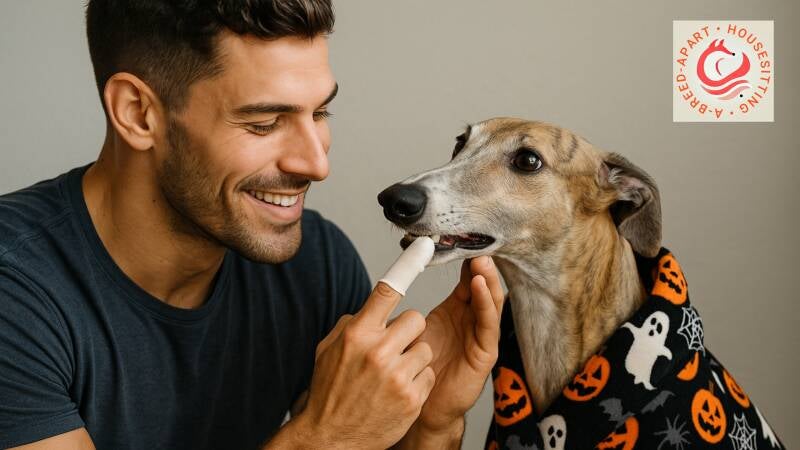Most dog owners wouldn’t dream of neglecting their own dental hygiene, yet the thought of brushing a dog’s teeth still brings a mixture of amusement and dread. But canine dental care isn’t a luxury, it’s a cornerstone of long-term health. Poor dental hygiene can lead to gum disease, tooth loss, pain, and even heart and kidney problems. The good news is that most dental issues can be prevented with simple, consistent care.
In this article, we’ll explore how to get ahead of dental disease, the breeds most prone to problems (and those that tend to escape them), and how to make dog dental care less of a chore and more of a bonding ritual.

Until quite recently, canine dental care was often overlooked. Many owners assumed that chewing on bones* was enough to keep teeth clean. However, veterinary science has revealed that around 80% of dogs show signs of dental disease by the age of three (RSPCA, 2023). Much like in humans, plaque builds up daily and, if left unchecked, hardens into tartar; the starting point for gum inflammation and tooth decay.
Luckily, awareness has grown. Today’s pet owners have access to a wealth of tools, from enzymatic toothpastes to dental toys and water additives, making prevention easier than ever.
*While chewing may help reduce plaque, bones (especially cooked ones) pose risks such as tooth fractures, intestinal blockage, or bacterial contamination.
Why Dental Health Matters
Healthy teeth and gums mean a healthier dog — full stop. Dental disease doesn’t just affect the mouth. Bacteria from infected gums can enter the bloodstream, affecting major organs like the liver, kidneys, and heart. The Dogs Trust highlights that oral health is a key indicator of a dog’s overall wellbeing (Dogs Trust: Dental Care for Dogs).
Signs of dental issues include:
- Bad breath
- Yellow or brown tartar build-up
- Red or bleeding gums
- Difficulty eating or chewing
- Pawing at the mouth
If you notice any of these, a vet visit is in order.
Dog Breeds Prone to Dental Problems
Some breeds are more susceptible to dental disease due to their mouth shape or size.
- Toy and small breeds like Yorkshire Terriers, Chihuahuas, Dachshunds, and Pomeranians often struggle because their teeth are crowded into small jaws. Crowding creates perfect pockets for plaque and bacteria to thrive.
- Brachycephalic (flat-faced) breeds, such as Pugs, Bulldogs, and Shih Tzus, also face challenges due to their jaw structure, which causes teeth to overlap.
- Greyhounds, surprisingly, are also known for dental issues — their slim jaws and thin gums make them prone to gum recession.

Conversely, larger breeds such as Labradors, Collies, and Retrievers tend to fare better, especially when given appropriate chews and diets that promote natural cleaning. However, no breed is immune — all dogs can develop tartar without proper care.

Never use human toothpaste as fluoride and xylitol are toxic to dogs

Yellow or brown build-up (plaque or tartar) on teeth is a symptom of dental problems
How to Keep Your Dog’s Teeth Clean
1. Brushing: The Gold Standard
Brushing is hands down the best way to prevent dental disease. Aim for three to four times a week (daily if possible). Use:
- A dog-specific toothbrush or finger brush
- A canine toothpaste (never use human toothpaste, as fluoride and xylitol are toxic to dogs)
Start slowly. Let your dog lick the toothpaste first, then gently lift their lip and brush the outer surfaces of the teeth in small circles. Praise and reward generously.
2. Dental Chews and Toys
Chewing is a natural behaviour that helps reduce plaque buildup. Choose VOHC-approved (Veterinary Oral Health Council) dental chews for effectiveness. Avoid overly hard chews like deer antlers or bones, which can fracture teeth.
3. Diet and Nutrition
Some veterinary dental diets, such as those approved by the Veterinary Oral Health Council (VOHC), are specially formulated to reduce plaque and tartar through kibble texture and added ingredients like sodium polyphosphates, which help prevent mineral build-up on teeth.
However, regular dry kibble does not provide significant mechanical cleaning and should not be relied upon as a dental care method on its own.
Offering raw, crunchy vegetables such as carrot sticks or apple slices (without seeds) can provide light mechanical action that may help dislodge soft plaque, but this should be seen as a healthy treat rather than a primary dental care tool.
4. Water Additives and Oral Sprays
If brushing isn’t practical, water additives can help reduce bacteria. These products are tasteless and easy to use, though they should complement, not replace, brushing.
5. Regular Vet Check-ups
Annual dental checks are essential. Vets can identify early signs of gum disease and recommend professional cleaning when needed. Professional cleaning involves scaling under anaesthetic — it’s safe, thorough, and well worth the investment for your dog’s comfort.
Natural Aids and Preventative Tips
- Some owners use coconut oil for its potential antimicrobial properties, but its effectiveness in dental health is unproven.
- Offer dental rope toys for gentle cleaning.
Keep an eye on bad breath, as it’s often the first sign of trouble.
Dog Dental Health Checklist
Signs Your Dog May Need a Dental Check
Keep an eye out for these warning signs of dental disease — catching them early can save your dog pain and protect their long-term health.
Mouth & Breath
☐ Bad breath (smells sour, rotten, or metallic)
☐ Drooling more than usual
☐ Blood in saliva or on toys
Teeth
☐ Yellow or brown build-up (plaque or tartar)
☐ Loose or missing teeth
☐ Teeth appear worn, broken, or discoloured
Gums
☐ Red, swollen, or bleeding gums
☐ Receding gumline (teeth look “longer” than before)
Eating & Chewing
☐ Hesitation to eat hard food
☐ Dropping food from the mouth while eating
☐ Chewing on one side only or pawing at the mouth
Behaviour & Appearance
☐ Avoiding head pats or facial touch
☐ Reduced playfulness or energy
☐ Facial swelling (especially under the eyes or along the jaw)
What to Do
If you’ve ticked even one or two boxes, it’s time for a vet dental check-up.
Most problems can be reversed or controlled if caught early and your dog will feel (and smell!) much better.
Marketplace
Vet Strength Pure Enzymatic Dog & Cat Toothpaste
Keep your pet’s smile healthy with vet-formulated enzymatic toothpaste, crafted to tackle tartar, plaque, and bad breath. Ideal for cats and dogs, it's gentle yet effective with no added nasties. Oral care has never been easier—or tastier!
👉 Check it out on Amazon
ICF Stomodine® Cat & Dog Toothpaste
Advanced dental care for sensitive pets! ICF Stomodine® combines anti-inflammatory ingredients with a pet-friendly formula to soothe gums and reduce oral bacteria. Perfect for pets with periodontal concerns.
👉 View it now on Amazon
Any products listed are affiliate recommendations – at no extra cost to you, we may earn a small commission if you purchase via these links, helping us keep guides like this free and full of practical advice.
Dental Care Powders: How Do They Work? Is It Proven?
What are they?
These products are made from a specific type of seaweed, Ascophyllum nodosum, which is claimed to:
- Reduce plaque and tartar
- Improve bad breath
Mechanism (claimed):
- Systemic effect: When ingested, compounds in the seaweed are absorbed and work systemically through the saliva to alter the bacterial biofilm and reduce plaque formation.
- Saliva composition changes: May reduce the adherence of plaque to teeth over time.
Is it proven?
- There is some evidence from small, independent veterinary studies showing modest improvements in plaque and calculus reduction.
- It's not as effective as tooth brushing, but can be a helpful adjunct, especially for dogs who don’t tolerate brushing.
One study (Gawor et al., 2018) found significant reductions in plaque after 30–60 days of use compared to placebo.
Caveats:
- Effects vary by individual dog and diet.
- Should not be used in dogs with thyroid conditions, due to iodine content.
- Not a substitute for brushing, but may be useful alongside brushing and chews.
Conclusion: Seaweed-based and similar powders are moderately effective, safe for most dogs, and may support oral health as part of a broader hygiene plan. Check with your vet before starting.
Dental care might seem fiddly at first, but it soon becomes second nature, and your dog will thank you for it with fresher breath, brighter eyes, and years of healthy smiles. If your dog’s never had their teeth brushed, start today. Go slowly, stay positive, and make it part of your routine.
If you’re planning to travel and want your dog’s dental routine maintained while you’re away, make sure your house sitter or pet sitter is briefed on your dog’s dental needs, a small detail that makes a big difference to your pet’s comfort and health.
At A-Breed-Apart, we ensure continuity of care for pets across the Cotswolds and South West, including bespoke feeding and health routines.

THE DOGGY DENTISTS Dog & Cat Finger Toothbrush Pack
Dental care made simple—just slip on and scrub! These ultra-soft silicone finger brushes make it easy to clean your pet’s teeth without stress. Ideal for daily use with your favorite pet toothpaste.
👉 Get the pack here

Wisdom Panel Essential: Dog DNA Test Kit
Uncover your dog’s breed, ancestry, and genetic traits with the most accurate dog DNA test on the market. Easy to use, fast results, and fascinating insights about your furry friend.
👉 Discover your dog’s DNA today

Pooch & Mutt - Dog Christmas Dinner Gift Box
Make your pup’s holiday extra special! This festive doggy dinner box includes tasty treats, a turkey dinner, and a sprinkle of Christmas cheer. Limited-edition and paw-fect for gifting!
👉 Snag the gift box here
Any products listed are affiliate recommendations – at no extra cost to you, we may earn a small commission if you purchase via these links, helping us keep guides like this free and full of practical advice.




Add comment
Comments
Hi, we've been giving our collie dental chews for the last 9 years now, as recommended by our vet, but have become aware they may be more of a gimmick than actually being functional.
I read this this morning which kind of summed it up, which seems so sensible - https://petfoodreviews.substack.com/p/do-you-brush-your-teeth-with-weet
Based on your experience, is this correct, and should we opt for more meat-based chews rather than common dental treats which look to be made more from cereals etc?